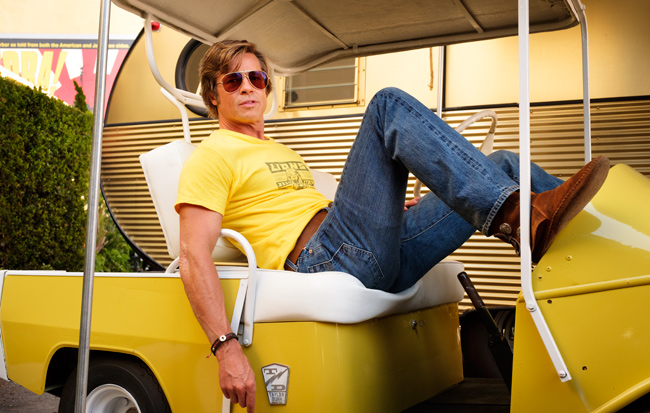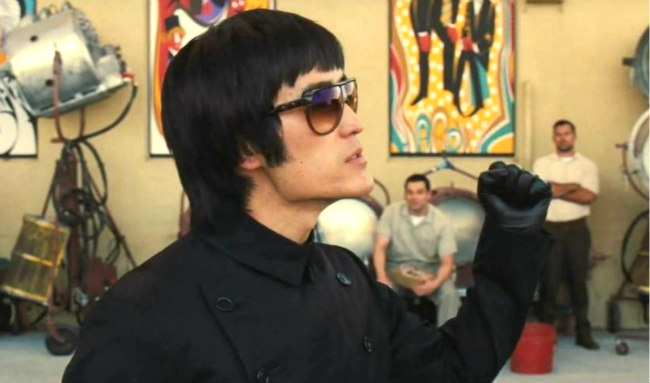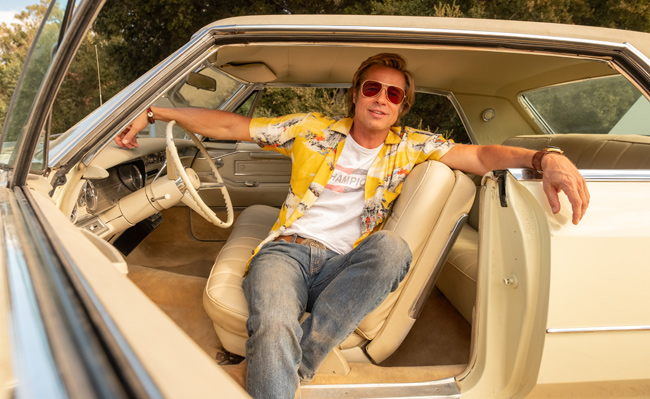
Now that Once Upon A Time In Hollywood is out (and doing pretty well for itself with the highest ever opening weekend for Tarantino) and you’ve clearly been warned in this headline, it’s time to discuss all those things about the movie we weren’t allowed to talk about in our two reviews of the movie (in fact, rumor has it Sony wasn’t happy about “spoilers” last week). All of which is to say… THIS ARTICLE WILL CONTAIN SPOILERS. DON’T READ IT IF YOU WANT TO AVOID THEM. YOU HAVE BEEN WARNED.
That Ending!
Once Upon A Time‘s bloody crescendo of an ending seems to be soaking up most of the post-release conversation and probably intentionally so. It feels polarizing by design. In a movie that didn’t scream “Tarantino movie” for most of its run time (though it did often do so at an average volume), the bloody ending almost felt like overcompensation, as if because there were no murders or exploding squibs in the first four-fifths of the movie the last bit had to double down on broken bones and spurting blood and brutal pitbull attacks.
Thing is… I hadn’t minded the lack of killing. The scene at Spahn Ranch — oddly reminiscent of Midsommar — evoked the full range emotions, probably everything we’re usually supposed to feel in a bloody revenge sequence, and with less blood outlay. In a way, it was also more brutal than the usual Tarantino severed limbs and exploding heads, because when Cliff Booth starts knocking out Clem’s teeth, we’re still experiencing it as a literal reality. We haven’t yet started to think about what we’re watching as a movie — history and alternate history haven’t started to separate.
Yet, while the bloody ending for me wasn’t as cathartic as similar scenes in Django or Inglourious, or as funny as in Hateful Eight, it did accomplish a few things. In probably the first Tarantino movie that could legitimately be called “languid” or “meandering,” the ending was the first scene that fit the film clearly into a specific genre. The last scene told us this was a revenge movie even if we hadn’t known it until that exact moment.
The movie also felt like a tease, maybe even a prequel or an origin story. Part of me still wants to see Tarantino direct an alternate history version of the ’70s where the Manson Family murders never happened. Most people use the Manson murders (along with the Hells Angels stabbing a guy at Altamont four months later) as the symbolic turning point when sixties optimism morphed into seventies paranoia — the place where the wave crashed and rolled back, as Hunter Thompson put it in Fear And Loathing in Las Vegas. What if those movies had never happened? How would Quentin Tarantino imagine it? I’d love to see that as an HBO series, a kind of West Coast version of The Deuce.
In a less conceptual sense, that orgy-o’-violence ending capped off an almost three-hour movie in a way that left many of us wanting more. In that way it was a feat. That being said, I was enjoying Once Upon A Time just fine as… well, whatever it was. As not a revenge movie. The ending jarred me out of the movie reality and into thoughts of Tarantino’s psychology and motivations. It gave the movie “purpose” and an ending in the abstract, but it also felt a little like Tarantino not entirely trusting himself to do something different, when that something different was totally working. (Also, our Steven Hyden has a theory about the ending that centers around the acid-laced cigarette you should check out.)

Whither Bruce Lee?
In the film, Cliff Booth and Bruce Lee have a brief fight scene on the set of The Green Hornet. It stems from Lee (played beautifully by Mike Moh) acting like a bit of a blowhard, telling the whole crew how his hands are registered as lethal weapons and whatnot. Booth laughs at him, and Lee challenges Booth to a friendly sparring session. Lee gets in the first shot, then Booth throws him into a car. The scene ends there, before the third and deciding point, so it’s a bit ambiguous. But you could argue that it implies that Booth could kick Bruce Lee’s ass, and at the very least depicts Lee as kind of obnoxious.
Since the movie came out, plenty of people have wondered why the movie “did Bruce Lee dirty,” and whether the movie has some anti-Bruce Lee bias. Lee’s daughter was reportedly upset that she wasn’t consulted for the film. As for the depiction, Bruce Lee biographer Matthew Polly didn’t seem to object. As he told The Wrap:
“The jump side kick at the end to Pitt’s chest is a pure Kato move. The initial series of punches that ‘Bruce’ throws and Pitt blocks, ending with Pitt trapping ‘Bruce’s’ arm is more like traditional Hong Kong kung-fu movie choreography, but Bruce is wearing the black gloves from Kato. So more or less, it’s Kato — a homage rather than a pure imitation.”
And, in case you were wondering: “There’s no record of Lee ever saying that his hands were registered as lethal weapons, and I doubt he ever did. But Lee was a big talker and liked to brag, so Tarantino is not too far off base riffing on Lee’s tough guy legend. Plus, it’s a great setup for Pitt’s punchline.”
When I watched, I did wonder if Tarantino, as a noted Sonny Chiba lover, has some reflexive dislike for Bruce Lee. I call this the “Elvis vs. The Beatles theory,” based on the way Mia Wallace (in a deleted scene from Pulp Fiction) divides the world into “Elvis people and Beatles people.”
“There are only two kinds of people in the world, Beatles people and Elvis people. Now Beatles people can like Elvis and Elvis people can like the Beatles, but nobody likes them both equally. Somewhere you have to make a choice. And that choice, tells you who you are.”
Does Tarantino divide the world into Bruce Lee people and Sonny Chiba people the way he divides them into Elvis People and Beatles People? And is this scene an affirmation of the fact that he’s not a Bruce Lee person?
Judging by the fact that Uma Thurman’s entire look in the Kill Bill movies was an undisguised Bruce Lee homage, my guess is no. As Tarantino said during the press tour, “If you’re going to try to set up how indestructible a person is, having them fight Bruce Lee and doing a good job [is the way to do it],” says Tarantino with a laugh. “He could either fight Bruce Lee or Jim Brown … either one would really set up [that] the guy is a badass. I like the fact most of that whole fight scene is done in one shot – that’s the part I was proud of.”
My take is that much of Tarantino’s motivation in making Once Upon A Time In Hollywood was so he could have a vehicle for him to relay all the weird bits of Hollywood trivia he knows. And one of those bits is that Bruce Lee helped teach Sharon Tate martial arts for her movie The Wrecking Crew, which Margot Robbie’s Tate goes to a matinee of in Once Upon A Time In Hollywood. In real life, Tate then introduced Bruce Lee to Jay Sebring (played by Emile Hirsch), who recommends Bruce Lee for The Green Hornet, the set of which provides the setting for the fictional Cliff Booth fight sequence.
My take? Tarantino takes Bruce Lee being a badass as such a given that he only considered how Bruce Lee would make Cliff Booth look rather than vice versa. He thought this scene would make Booth more without making Lee less, since Bruce Lee’s badassness was self-explanatory. (Of course he’s badass, he’s Bruce Lee!) Whether Tarantino entirely pulled that off… well, your mileage may vary. I enjoy the scene in a way that probably doesn’t cheapen Lee’s legacy.

Cliff Booth’s Past
Ah yes, about that whole wife-killing thing…
Whereas most of Once Upon A Time In Hollywood is about two fictional characters whose lives eventually intersect with the real-life Manson Family, Tarantino seems to have incorporated a bit of Natalie Wood’s fatal boat ride (which wouldn’t happen until 1981) into his back story for Brad Pitt’s character, Cliff Booth. People whisper “did you hear he killed his wife?” and we eventually get a brief flashback to the incident.
In the flashback, Booth and presumably his wife (Rebecca Gayheart) are on a boat somewhere. We see Booth soaking up her shrill nagging — she’s really on one about something — as he puts on his James Bond-esque ’60s spearfishing gear. Her rant seems to near a crescendo just as Booth pulls on his oval-shaped snorkel mask and levels his spear gun at her — though it could just be resting on his leg — a slightly inscrutable but mildly exasperated look on his face… and that’s where the scene ends.
It’s somewhat ambiguous, but in the absence of any exculpatory evidence…
It’s hard to know exactly what we’re supposed to think about it. As I wrote in my review, Quentin Tarantino seemed to think Cliff Booth was extremely cool. Admittedly, part of that is projection. I thought Cliff Booth was extremely cool. It’s been a long time since I wanted to steal a person’s style as much as I wanted to steal Brad Pitt’s in Once Upon A Time In Hollywood. If Entourage had been as fun to watch as Brad Pitt and Leonardo DiCaprio driving around Hollywood in a Cadillac, it probably wouldn’t have sucked so bad.
Was that part of Tarantino’s purpose, to give us this sense of moral ickyness, where we question ourselves for idolizing a guy who killed a woman simply because he wears cool Hawaiian shirts and drinks Bloody Marys on planes? Could be, though Tarantino tends not to be quite that introspective. I read Cliff Booth’s past more as Tarantino’s attempt to give us an anti-hero.
There’s an entire subplot in Once Upon A Time In Hollywood about Leo’s character, Rick Dalton, debating whether he should go off to Italy to make what would come to be known as a Spaghetti Western. Later in the movie, there’s a didactic aside — arguably the most straightforwardly didactic explanation of cinematic influences in all the Tarantino canon — where we learn all about Spaghetti Westerns, from the post-synchronous dialogue to the “tower of babel” production style.
One of the key innovations Spaghetti Westerns are generally credited with is introducing the idea of the anti-hero. That is, a protagonist who was flawed and/or amoral, in contrast to the white hats from early American westerns. Cliff Booth, possible wife murderer, seems to fit that bill. He seems incredibly cool and a great pitbull dad with an aspirational/unattainable physique, yet we can’t get too invested in him as our idealized self/daddy figure because he also may have killed his wife. Not to mention his tendency towards homicidal anger and a violent hatred of hippies. Though antiheroes tend to be gruff, outwardly frosty and crotchety. Cliff on the other hand mostly just seems like a fun chill guy to hang with. I’m not quite sure convinced he fits the anti-hero bill. Depending on how you interpret the flashback, he might be more of a sociopath.
In any case, if the goal was to make us feel morally conflicted and have lots of arguments about Cliff Booth and what exactly Tarantino intended, Once Upon A Time In Hollywood is successful. If the goal was to make us wholeheartedly root for him in the final scene… I’d call the outcome mixed. I wanted to root for a guy to thwart the Manson Family, but that got a little tangled up with wondering whether the hero’s superpower was killing women. Poetic justice? These problematic delights have problematic ends…
People keep calling Once Upon A Time In Hollywood “Tarantino’s most personal film,” to the point that it’s practically a subtitle. I’m not sure if “personal” is the right word (reactionary?), but whatever you think of Tarantino movies, it’s nice that people care about them enough to debate them. In 2019, it’s nice to talk about a movie as a cultural product rather than just a commercial one.
Vince Mancini is on Twitter. You can access his archive of reviews here.






